 |
Paris, France View from the top of the Eiffel Tower. |
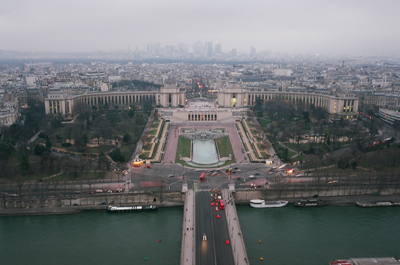 |
Paris View from the top of the Eiffel Tower. |
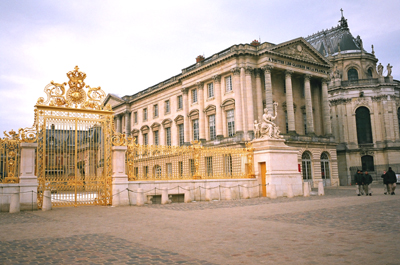 |
Versailles The Golden gates at the entrances of Versailles palace where Louis XIV the sun king lived. |
| Versailles - | |
| Versailles Notre Dame at Versailles | |
| Versailles The interior of Notre Dame at Versailles | |
| PARIS FRANCE Feb 2025 | |
| Eiffel Tower
Location: Paris, France The Eiffel Tower is located at Champ de Mars. It is a wrought-iron lattice tower named after engineer Gustave Eiffel, whose company designed and built the tower from 1887 to 1889. It was the centerpiece of the 1889 World's Fair. It was initially criticized but has become a global cultural icon of France and one of the most recognizable structures in the world. It got 5,889,000 visitors in 2022. It is the most visited monument with an entrance fee in the world. In 1964, it was named part of a UNESCO World Heritage Site. The tower is 1,083 ft (330 meters) tall, the height of an 81-storey building, and the tallest structure in Paris. Its square base is 410 feet (125 meters) on a side. The Eiffel Tower was the tallest human-made structure in the world, a title held for 41 years until 1930 when the Chrysler Building in New York City was finished. It was the first structure in the world to surpass both the 650 feet (200-meter) and 984 feet (300-meter) mark in height. With a broadcasting aerial added in 1957, it is now taller than the Chrysler Building by 17 feet (5.2 meters). The tower has three levels for visitors, with restaurants on the first and second levels. The top level's upper platform is 906 ft (276 m) above the ground. Tickets can be purchased to ascend by stairs or lift to the first and second levels. On the top, third level there is a private apartment that was built for Gustave Eiffel's personal use. | |
| The Arc de Triomphe de l'Etoile
Location: Paris, France The Arc de Triomphe de l'Etoile, sits at the western end of the Champs-Elysees at the center of Place Charles de Gaulle, formerly named Place de l'Etoile the etoile or "star". It is the hub of a twelve avenue spoke that radiates from it. Its plaza straddles three arrondissements, the 16th, 17th, and 8th. The Arc de Triomphe honors those who fought in the French Revolutionary and Napoleonic Wars, with the names of French victories and generals inscribed on its surfaces. Beneath its vault lies the Tomb of the Unknown Soldier from World War I. The arc sits at the head of the Axe historique (historic axis) are a sequence of monuments and thoroughfares. The Arc de Triomphe was designed by Jean Chalgrin in 1806. It set the stage for other public monuments with patriotic messages. It has a height of 164 feet (50 m), width of 148 feet (45 m) and depth of 72 feet (22 m). The Arc de Triomphe was the tallest triumphal arch until the completion of the Monumento a la Revolucion in Mexico City in 1938, which rises 220 feet (67 m) high. The Arch of Triumph in Pyongyang, completed in 1982, is 197 feet (60 m). The Grande Arche in La Defense near Paris is 361 feet (110 meters) high is the world's tallest. | |
| Notre Dame de Paris Cathedral
Location: Paris, France In French meaning "Cathedral of Our Lady of Paris". It is a medieval Catholic cathedral on the Ile de la Cite (a River Seine Island). 12 million people visit Notre-Dame annually. The cathedral, dedicated to the Virgin Mary ("Our Lady"), is an example of French Gothic architecture. The pioneering use of the rib vault and flying buttress sets it apart from the earlier Romanesque style. Its colorful rose windows, and sculptural decoration were novel. Notre-Dame has three pipe organs and large church bells. Construction began in 1163 under Bishop Maurice de Sully and was completed by 1260. In the 1790s, during the French Revolution, Notre-Dame suffered desecration; its religious imagery damaged or destroyed. In the 19th century, it hosted the coronation of Napoleon. Victor Hugo's 1831 novel The Hunchback of Notre-Dame led to its restoration between 1844 and 1864, supervised by Eugene Viollet-le-Duc. On August 26, 1944, the Liberation of Paris from German occupation was celebrated in Notre-Dame with the signing of the Magnificat. Restoration projects in 1963 and 2000 cleaned it. A fire in April 2019 caused serious damage, closing the cathedral for repairs; it reopened in December 2024. In 1805, it was awarded status as a minor basilica. Notre-Dame contains the cathedra or seat of the archbishop of Paris. Notre Dame contains Gothic, Baroque, and 19th-century sculptures and important Christian relics, including the crown of thorns, and a nail from the True Cross. | |
| Louvre Top 10
Location: Paris, France The Louvre is a French national Art Museum and is one of the most famous museums in the world. It was the #1 most visited museum in 2024 attracting 8.7 million visitors. It is housed in the Louvre Palace, built in the late 12th to 13th century under Philip II. In 1546, Francis I converted it into the residence of the French kings. In 1682, Louis 14 moved to the Versailles Palace and left the Louvre as a place to display the royal collection. From 1692, it displayed a collection of ancient Greek and Roman sculpture. During the French Revolution, the National Assembly decreed the Louvre to be a national art museum. The museum opened to the public on 10 August 1793 hosting 537 paintings. The collection was increased under Napoleon, through the looting of art in Europe, Egypt, and Syria and further increased during the reigns of Louis XVIII and Charles X, and during the Second French Empire by 20,000 pieces. Today, the Louvre contains 500,000 objects and displays 35,000 works of art divided into eight curatorial departments. Decorative Arts; Egyptian Antiquities; Greek, Etruscan, and Roman Antiquities; Islamic Art; Near Eastern Antiquities; Paintings; Prints and Drawings; Sculpture; It has 652,000 sq ft (60,600 sqm) dedicated to the permanent collection. The Louvre exhibits sculptures, objets d'art, paintings, drawings, and archaeological finds. With 35,000 objects on exhibit it the largest museum in the world. | |
 |
Louvre Top 10:
#1 Mona Lisa / Leonardo da Vinci 1506 Renaissance
Location: Paris, France The Mona Lisa was created by Italian artist Leonardo da Vinci. It is said to be the best known, the most visited, the most written about, the most sung about and, most parodied work of art in the world. It depicts the Italian noblewoman Lisa del Giocondo and is painted in oil on a white poplar panel. It was painted between 1503 and 1506. King Francis I of France acquired the Mona Lisa after Leonardo's death in 1519, and it is now the property of the French Republic. It has been on display at the Louvre since 1797. The painting's global fame and popularity grew from its 1911 theft by Vincenzo Peruggia, who stole it out of Italian patriotism believing it should belong to Italy. It was recovered in 1914 and generated global publicity, which led the 1915 opera Mona Lisa, two 1930 films (The Theft of the Mona Lisa and Arsene Lupin), and the song "Mona Lisa" by Nat King Cole in the 1950s. The Mona Lisa is the most valuable painting in the world holding the Guinness World Record for the highest known painting insurance valuation in history at $100 million US in 1962, equivalent to $1 billion as of 2023. |
 |
Louvre Top 10:
#2 Venus de Milo / Alexandros Antioch 160BC Hellenistic Era
Location: Paris, France Also known as Aphrodite of Melos. It is a Hellenistic era Greek marble ancient sculpture made between 160 and 110 BC. It was found on the island of Milos in the Cyclades in Greece on April 1820. It has been on display at the Louvre Museum since 1821. The Venus de Milo became a cornerstone of the Louvre's antiquities collection, and its fame spread through distribution in photographs and copies. It was crafted by Alexandros from Antioch. Since its discovery, it has become one of the most famous works of ancient Greek sculpture in the world. The Venus de Milo depicts Aphrodite, the Greek goddess of love, whose Roman counterpart was Venus. It is made of Parian marble and stands 6 feet 7 inches high. The statue is missing both arms. It depicts Aphrodite holding the apple of discord as a marble hand holding an apple was found beside it. The statue inspired 70 poems, influenced 19th-century art and the Surrealist movement in the early 20th century. It has been featured in modern artistic projects, film, and advertising. |
 |
Louvre Top 10:
#3 Winged Victory of Samothrace / 190BCE Hellenistic Era
Location: Paris, France Also known as the Nike of Samothrace. It was discovered on the island of Samothrace in Greece in the Aegean Sea. It is a Hellenistic era Greek sculpture, dating from 190 BCE in the 2nd century. It is represents the goddess of Victory, Nike, her head and arms are missing. It sits on a base in the shape of a ship's bow. The composition stands at 18 ft 3 in (5.57 meters). Nike itself measures 9ft (2.75 meters). It is one of the few original Hellenistic statues, rather than a Roman copy. Winged Victory has been exhibited at the Louvre, since 1884. |
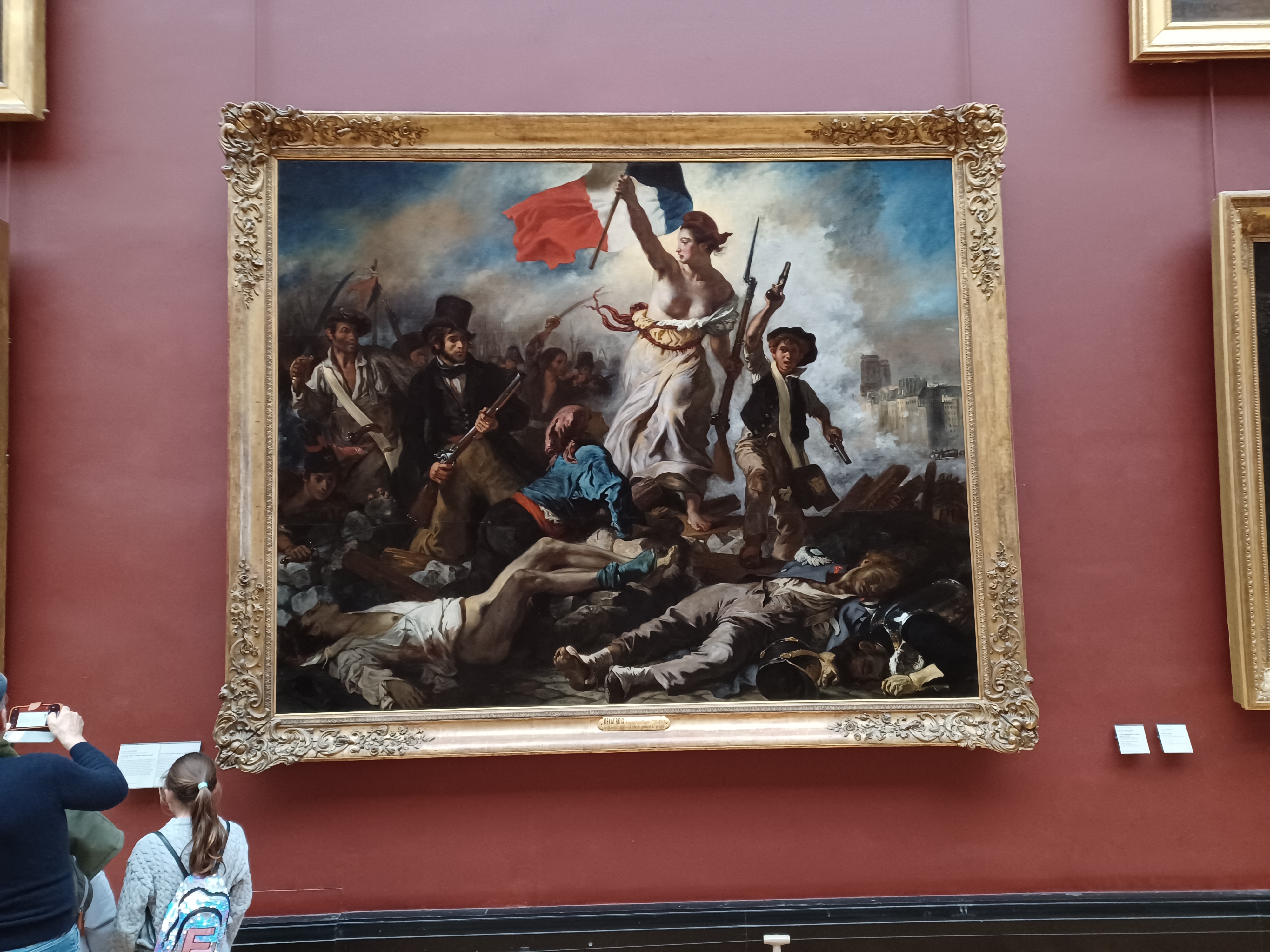 |
Louvre Top 10:
#4 Liberty Leading the People / Eugene Delacroix 1831 Romanticism
Location: Paris, France In French: La Liberte guidant le peuple. Painted by the French artist Eugene Delacroix in the Romantic era, commemorating the July Revolution of 1830 that toppled King Charles X (r. 1824-1830). A bare-breasted "woman of the people" with a Phrygian cap personifying the concept and Goddess of Liberty, accompanied by a young boy brandishing a pistol in each hand, leads a group of various people forward over a barricade and the bodies of the fallen while holding aloft the flag of the French Revolution - the tricolour, which became France's national flag after these events - in one hand, and brandishing a bayonetted musket with the other. The figure of Liberty is also viewed as a symbol of France and the French Republic known as Marianne. It is sometimes wrongly thought to depict the French Revolution of 1789. When Delacroix painted this, he was the acknowledged leader of the French Romantic school. He was born as the Enlightenment Age was giving way to the ideas and style of romanticism, which rejected the emphasis on precise drawing and promoted freely brushed color. It was exhibited at the official Paris Salon of 1831. |
 |
Louvre Top 10:
#5 The Coronation of Napoleon / Jacques-Louis David 1807 Neoclassic
Location: Paris, France In French: Le Sacre de Napoleon was painted by Jacques-Louis David completed in 1807. He was the official painter of Napoleon, depicting the coronation of Napoleon at Notre-Dame de Paris where Napoleon crowned himself and his wife Emperor and Empress of the French in the presence of his family, the Pope and dignitaries. The oil painting spans 33 feet (10 meters) wide by 20 feet (6 meters) tall. It was commissioned by Napoleon in September 1804, and David started work on it on December 21, 1805. It was done at the College of Cluny. David was assisted by Georges Rouget, who made the finishing touches in January 1808. The painting remained the property of David until 1819. Tehn, it was moved to the Royal Museums. It was installed in Palace of Versailles. In 1889, it was transferred to the Louvre. David was commissioned by American entrepreneurs to paint a full size replica, in 1808. He began work that year, painting it from memory, and finished it in 1822. The replica was returned to France in 1947, to its original place in the Palace of Versailles. |
 |
Louvre Top 10:
#6 The Raft of the Medusa / Theodore Gericault 1819 Romanticism
Location: Paris, France (French: Le Radeau de la Meduse). By Theodore Gericault in 1818-1819. An oil painting of French Romantic period. He was 27. It is an icon of French Romanticism. It launched Gericault's career. It is 16' 1" x 23' 6". It depicts the aftermath of the wreck of the French naval frigate Meduse, which ran aground off the coast of today's Mauritania on 2 July 1816. On 5 July 1816, at least 150 people were set adrift on a makeshift raft; all but 15 died in the 13 days before their rescue. Those who survived endured starvation, dehydration and practiced cannibalism. The event was an international scandal, because of the incompetence of the French captain. The story garnered widespread public interest. Before Gericault began work, he researched and produced preparatory sketches. He interviewed survivors and constructed a detailed scale model of the raft. He visited hospitals and morgues where he viewed the color and texture of the flesh of the dying and dead. The painting was controversial when it first appeared in 1819, eliciting praise and condemnation. It established his international reputation and is now seen as a seminal work in the French Romantic painting movement. His painting broke from the calm and order of the prevailing Neoclassical school. Gericault's work attracted wide attention from its first showing. The Louvre acquired it after his death at the age of 32. The painting influenced the works of Eugene Delacroix, J. M. W. Turner, Gustave Courbet, and Edouard Manet. |
 |
Louvre Top 10:
#7 The Wedding at Cana / Paolo Veronese 1563 Mannerist Style
Location: Paris, France Paolo Veronese (1563). It depicts the biblical story of the Wedding at Cana, where Jesus converts water into red wine foreshadowing the Eucharist described in the Book of John Chapter 2: verse 1-11. It is a Mannerist style work (1520-1600) of the late Renaissance. It is a huge (32'7 x22'3) oil painting in the stylistic ideal of compositional harmony, as practiced by the artists Leonardo, Raphael, and Michelangelo. The art of the High Renaissance (1490-1527) emphasised human figures of ideal proportions, balanced composition, and beauty. Whereas Mannerism exaggerated the Renaissance ideals: of figure, light, and color - with asymmetric and elegant arrangements achieved by flattening the drawing space and distorting the human figure as an ideal preconception of the subject, rather than as a realistic representation. The visual tension among the elements of the picture and the thematic instability among the human figures in The painting derive from Veronese's application of technical artifice, the inclusion of sophisticated cultural codes and symbolism (social, religious, theologic), which present a biblical story relevant to the Renaissance viewer and to the contemporary viewer. From the 16th to the 18th centuries, it was at the San Giorgio Monastery. In 1797, Napoleon's Army plundered it as war booty during the French Revolutionary Wars (1792-1802). The pictorial area (67.29 m2) of the canvas makes The Wedding Feast at Cana the most expansive picture in the Louvre. |
 |
Louvre Top 10:
#8 Oath of the Horatii / Jacques-Louis David / 1785 Neoclassical
Location: Paris, France French: Le Serment des Horaces. Jacques-Louis David (French) in 1784-1785. It was a success and remains a paragon of Neoclassical art. It shows a scene from the story of the Horatii and Curiatii, which is a Roman legend about a seventh-century BCE dispute between two warring cities, Rome and Alba Longa, that emphasizes patriotism and self-sacrifice for one's country. Instead of the two cities warring, they agree to choose three men from each city; the victor of that fight will be winner. From Rome, three brothers from the Horatii family agree to fight three brothers from a family of Alba Longa, the Curiatii. The three brothers, stretch their hands towards their father who holds their swords out to them. Only Publius will survive the confrontation. Publius kills the other three fighters from Alba Longa: because he allows the three fighters to chase him, causing them to separate from each other, and, in turn, kills each Curiatii brother. In the bottom right corner is Camilla, a sister of the Horatii brothers, also betrothed to one of the Curiatii fighters, and thus weeps because whatever happens, she will lose someone. Publius, kills Camilla for weeping over the enemy. Source for the story is the first book of Livy (sections 24-26) by Dionysius in book 3 of his Roman Antiquities. The moment in David's painting is from his imagination. |
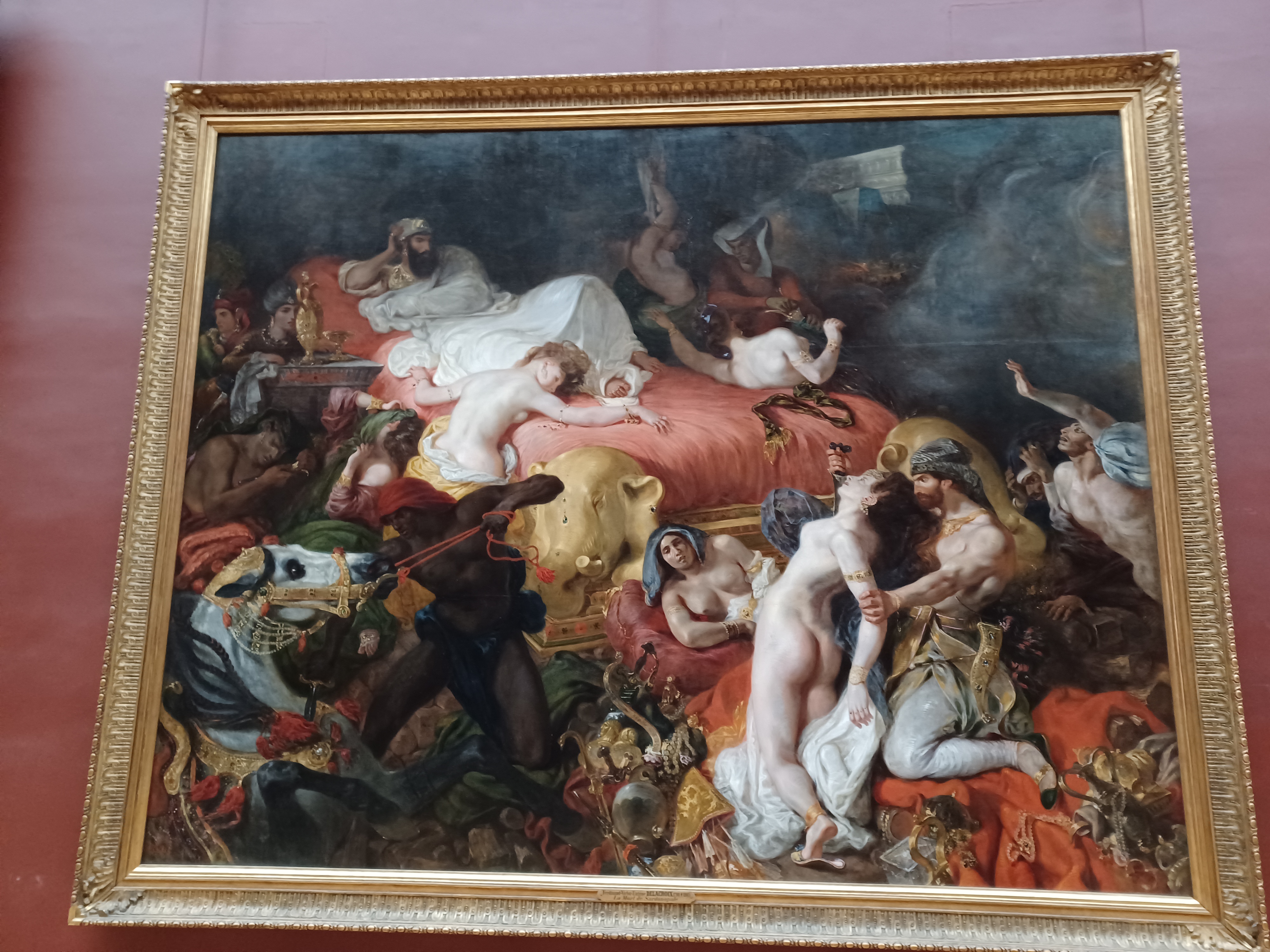 |
Louvre Top 10:
#9 The Death of Sardanapalus / Eugene Delacroix / 1827 Romanticism
Location: Paris, France In French: La Mort de Sardanapale. Eugene Delacroix (French) 1827. Romanticism era oil on canvas based on the tale of Sardanapalus, a king of Assyria from the History of Persia by Ctesias of Cnidus (5th century BCE) and the tragedy Sardanapalus by Lord Byron (1788-1824). Sardanapalus was a legendary king of Assyria (ancient Mesopotamia) famed for his debauchery. When enemies attacked his palace, he refused to fight; instead, he ordered that he be burned on an immense pyre together with all the objects of his pleasure: concubines, slaves, horses and precious items. The painting's chaotic composition, sensuality and violence were sharply criticized by viewers and journalists when it was first shown. |
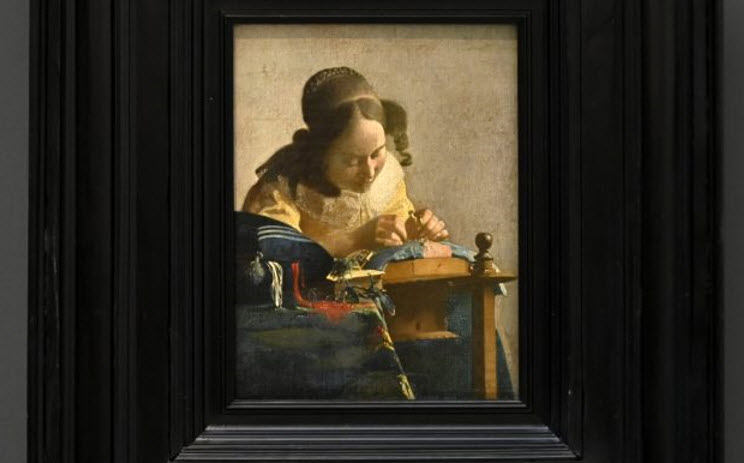 |
Louvre Top 10:
#10 The Lacemaker / Johannes Vermeer 1670 Baroque Era
Location: Paris, France Created by Dutch artist Johannes Vermeer (1632-1675), completed in 1670. At 9.6 in x 8.3 in (24.5 cm x 21 cm), it is the smallest of Vermeer's paintings. As with his The Astronomer (1668) and The Geographer (1669), Vermeer carefully studied before painting; the art of lacemaking is portrayed closely and accurately. Some believe Vermeer may have used a camera obscura while composing the work: many optical effects typical of projection can be seen, in particular the blurring of the foreground. By rendering areas of the canvas as out-of-focus, Vermeer suggests depth of field in a manner unusual of Dutch Baroque painting of the era. The lace is shown as extending from the sewing cushion, contrasting with the precision of the lace she is shown working on. |
 |
Champs Elysees Avenue (Elysian Fields)
Location: Paris, France The Avenue des Champs-Elysees is an avenue in the 8th arrondissement of Paris, France. The name is French for the Elysian Fields, the place for dead heroes in Greek mythology. It is 1.2 miles (1.9 kilometers) long and 230 feet (70 meters) wide, running between the Place de la Concorde in the east and the Place Charles de Gaulle in the west, where the Arc de Triomphe is located. It is known for its theatres, cafes, and luxury shops. It has been described as the "most beautiful avenue in the world". |
 |
Moulin Rouge
Location: Paris, France Moulin Rouge (French meaning "Red Mill") is a cabaret in Paris. In 1889, Charles Zidler and Joseph Oller, cofounded it. Fire destroyed the original venue in 1915 and was rebuilt in 1925. Moulin Rouge has a landmark red windmill on its roof. It is best known as the birthplace of the can-can dance. Originally introduced as a seductive dance by the courtesans, the can-can dance revue evolved into a form of entertainment of its own right that led to cabarets across Europe. Today, the Moulin Rouge is a tourist attraction, offering musical dance entertainment. |
 |
Versailles Palace
Location: Paris, France The Palace of Versailles is a former royal residence of King Louis XIV located in Versailles, 11 miles (18 kilometers) west of Paris, in the Yvelines Department of Ile-de-France region. The palace is owned by the government of France and since 1995 has been managed by the Public Establishment of the Palace, Museum and National Estate of Versailles. 15,000,000 people visit it annually, making it one of the most popular tourist attractions in the world. Louis XIII built a hunting lodge at Versailles in 1623. Louis XIV, expanded the chateau into a palace that went through expansions from 1661 to 1715. In 1682, Louis XIV moved the seat of his court and government to Versailles, making the palace the de facto capital of France. Kings Louis XV and Louis XVI made interior alterations to the palace. In 1789 the royal family and French court returned to Paris. During the French Revolution, the Palace of Versailles was abandoned and emptied. After coronation as Emperor, Napoleon used the subsidiary palace, Grand Trianon, as a residence from 1810 to 1814, but did not use the main palace. After the Bourbon Restoration, he resided in Paris. In the 1830s repairs were made to the palace. The palace and park were designated a World Heritage Site by UNESCO in 1979 for its importance as the center of power, art, and science in France during the 17th and 18th centuries. |